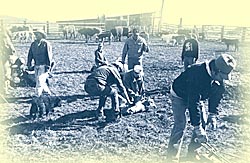Today, many Native families continue to ranch, grazing their cattle on private holdings, commonly held reserve land, federal reserves or Crown land. Like their non-Native counterparts, Native cattlemen must often supplement their income by working in neighbouring towns or for other ranchers. Many women work on the ranch alongside their husbands, fathers and brothers. Some people find work as teachers, social workers or businesspeople, and help with the ranching chores after work and on weekends. Children learn at an early age to ride horses, tend cattle and help with the chores, especially at harvest time and branding time. Given the economic situation of the past fifteen years, many Native ranchers feel that the future does not look promising as far as having their children continue to work the family farm and ranch. The cost of maintaining and buying equipment, grain and feed is so high that it is nearly impossible to start a new ranching operation unless the equipment, cattle and land are inherited. However, for many people, the one thing they will never give up is their horses.
Introduction | Early Ranching | Ranching Life | Contemporary Ranching Life | Community Stories | Transition to Rodeo SACRED BEINGS | RANCHING | ENTERTAINMENT | RODEO | ARTS AND INDUSTRIES |



